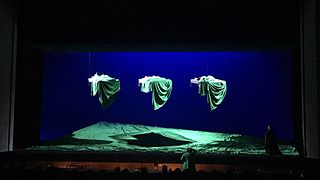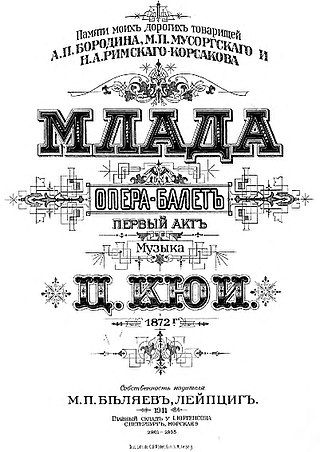
Don Giovanni is an opera in two acts with music by Wolfgang Amadeus Mozart to an Italian libretto by Lorenzo Da Ponte. Its subject is a centuries-old Spanish legend about a libertine as told by playwright Tirso de Molina in his 1630 play El burlador de Sevilla y convidado de piedra. It is a dramma giocoso blending comedy, melodrama and supernatural elements. It was premiered by the Prague Italian opera at the National Theater, now called the Estates Theatre, on 29 October 1787. Don Giovanni is regarded as one of the greatest operas of all time and has proved a fruitful subject for commentary in its own right; critic Fiona Maddocks has described it as one of Mozart's "trio of masterpieces with librettos by Da Ponte".

Dmitry Stepanovich Bortniansky was a Russian Imperial composer of Ukrainian Cossack origin. He was also a harpsichordist and conductor who served at the court of Catherine the Great. Bortniansky was critical to the musical history of both Russia and Ukraine, with both nations claiming him as their own.

Tamara Toumanova was a Russian-born Georgian-American prima ballerina and actress. A child of exiles in Paris after the Russian Revolution of 1917, she made her debut at the age of 10 at the children's ballet of the Paris Opera.

Uzeyir bey Abdulhuseyn bey oghlu Hajibeyov was an Azerbaijani composer, musicologist and teacher. He is recognized as the father of Azerbaijani classical music.

Russian rock music originated in the Soviet Union in the 1960s based on the influence of Western rock music and bard songs, and was developed by both amateur bands and official VIA.

A Midsummer Night's Dream, Op. 64, is an opera with music by Benjamin Britten and set to a libretto adapted by the composer and Peter Pears from William Shakespeare's play, A Midsummer Night's Dream. It was premiered on 11 June 1960 at the Aldeburgh Festival, conducted by the composer and with set and costume designs by Carl Toms. Stylistically, the work is typical of Britten, with a highly individual sound-world – not strikingly dissonant or atonal, but replete with subtly atmospheric harmonies and tone painting. The role of Oberon was composed for the countertenor Alfred Deller. Atypically for Britten, the opera did not include a leading role for his partner Pears, who instead was given the comic drag role of Flute/Thisbe.

Mlada was a project conceived in 1870 by Stepan Gedeonov (1816–1878), director of the Saint Petersburg Imperial Theatres, originally envisioned as a ballet to be composed by Aleksandr Serov with choreography by Marius Petipa.

Grigory Samuilovich Frid, also known as Grigori Fried, was a Russian composer of music written in many different genres, including chamber opera.

Prisoner of the Caucasus is an opera in three acts, composed by César Cui. The libretto is credited to Viktor Krylov, and is based on Alexander Pushkin's 1822 poem The Prisoner of the Caucasus.

Il Demofonte, also: Demofonte, Demofoonte or Demofont is an opera seria by the Ukrainian composer Maksym Berezovsky (1745–1777) composed in 1773 to an Italian libretto by Pietro Metastasio.
Mikhail Alexeyevich Matinsky was a Russian scientist, dramatist, librettist and opera composer.

Hamlet is a grand opera in five acts of 1868 by the French composer Ambroise Thomas, with a libretto by Michel Carré and Jules Barbier based on a French adaptation by Alexandre Dumas, père, and Paul Meurice of William Shakespeare's play Hamlet.

Eugen Doga is a Moldovan composer. He has made significant contributions to various forms of music during his career.

Stone sculptures of horses and sheep – are zoomorphic headstones, spread in the South Caucasus, Western Armenia and Iranian Azerbaijan, the main part of which is dated back to the 13th-19th centuries.
In 19th-century Italian opera, la solita forma is the formal design of scenes found during the bel canto era of Rossini, Bellini, Donizetti up to the late operas of Verdi. The English phrase—"multipartite form"—is most often used by American musicologist Philip Gossett, beginning with a 1974 essay, where referring to a general framework of melodramatic scene types, especially duets. Each scene gradually progresses from an opening static lyric moment to a finale through several standard musical tempos and set pieces, gradually adding characters and adding or unraveling complexity in the plot.

The Redemptoris Mater Chapel formerly known as Matilde Chapel, is a Roman Catholic chapel located on the second floor of the Apostolic Palace in Vatican City. Located just outside the doors of the papal apartments, the chapel is notable for its various mosaics similar to early Byzantine religious artwork, and is reserved for the exclusive use of the Pope.
Salawat Yulayev is an opera in four acts and seven scenes by the Bashkir composer Zagir Ismagilov.

Eugene Lavrenchuk is a Ukrainian opera and drama director, producer and teacher. Director, co-founder (2002), and artistic director of the Polish Theatre in Moscow (2002–2014) and the School of acting and directing. Chief director of the Odesa National Opera House (2018–2021). Rector of the First Ukrainian School of Theater and Cinema (2018), Founder and Head of the Expert Council of the All-Ukrainian Opera Forum. Has staged more than 30 plays (performances-list). Makes productions and also carries out active teaching work in Ukraine, Poland, Germany, Lithuania and Israel. The author of the methodology of teaching acting skills and directing. Merited Artist of Ukraine (2021).

Ventsislav Metodiev Mutafchiyski is a Bulgarian military doctor, professor and director at the Military Medical Academy (MMA), Major General from the Military Medical Service, and former Head of the National Operational Headquarters for Fight with Coronavirus Pandemic in Bulgaria.
Klara Milich(Russian: Клара Милич, tr.Klara Milich) is an opera in four acts and six scenes by the Russian composer Alexander Kastalsky based on the eponymous story by Ivan Turgenev published in 1883. The piano score of the opera was published in 1908 by Jurgenson's publishing house and premiered on November 11, 1916, at the Zimin Opera House in Moscow. The story centers around the death of the main protagonist Klara Milich, and the work is characterized as being a oneiric, or an appeal to introspection and a destabilization between psychological states of awareness and dreaming.















